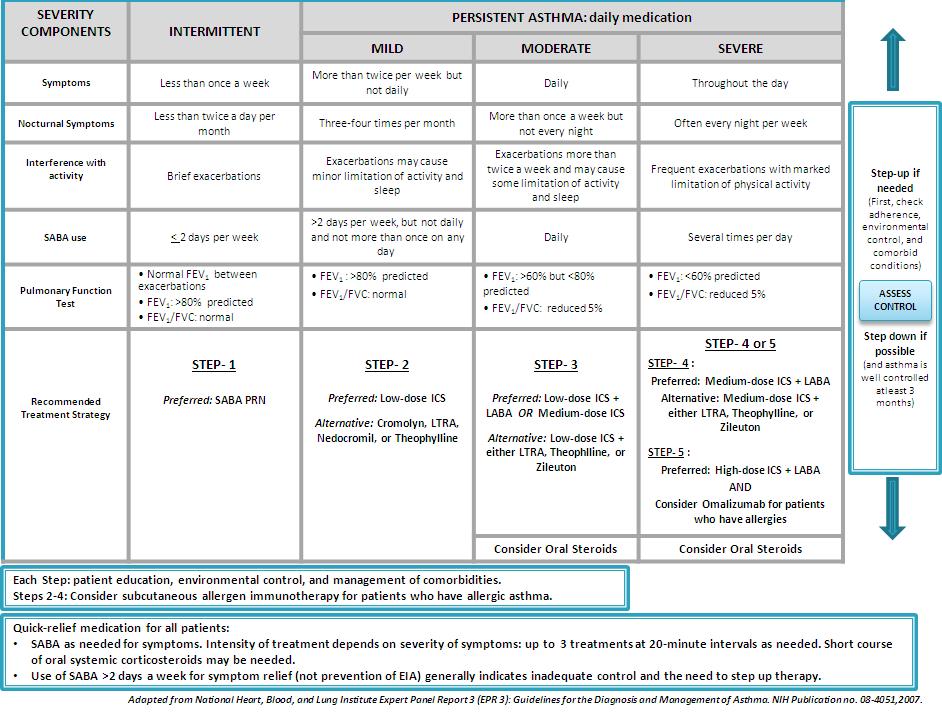Asthma classification
|
Asthma Microchapters |
|
Diagnosis |
|---|
|
Other Diagnostic Studies |
|
Treatment |
|
Case Studies |
|
Asthma classification On the Web |
|
American Roentgen Ray Society Images of Asthma classification |
Editor-In-Chief: C. Michael Gibson, M.S., M.D. [1]; Associate Editor(s)-In-Chief: Lakshmi Gopalakrishnan, M.B.B.S. [2]
Overview
Asthma is classified into atopic and non-atopic types based on the onset of symptoms as either early-onset or late-onset respectively. However, a significant degree of overlap exists between the two types. The severity of symptoms is further classified based on the GINA severity grades into mild intermittent, mild persistent, moderate persistent and severe persistent asthma.
Classification Based on Symptom Onset
Early-onset Asthma (Atopic, Allergic, Extrinsic)
- Early-age of onset
- Atopic individuals have an increased predisposition
- Environmental allergens play a strong role in the pathogenesis
- Positive personal and/or family history of atopic diseases such as allergic rhinitis, urticaria and eczema
- Laboratory tests may reveal increased serum IgE levels, positive skin test to specific aero-allergens and a positive bronchoprovocation test
Late-onset Asthma (Non-Atopic, Idiosyncratic, Intrinsic)
- Late-age of onset
- Non-atopic individuals have an increased predisposition
- Indoor allergens play a strong role in the pathogenesis
- Negative personal and/or family history of allergic diseases
- Laboratory tests may reveal normal serum IgE levels and a negative bronchoprovocation test
Classification Based on GINA Severity Grade
Asthma is classified into four subgroup, namely, mild intermittent, mild persistent, moderate persistent and severe persistent based on the Global Initiative for Asthma - GINA severity grades.[1]
Mild Intermittent Asthma
| Symptoms per day | Symptoms per night | PEF or FEV1 | PEF variability |
| Less than once a week. Brief exacerbations. Asymptomatic and normal PEFR between exacerbations. | Less than or equal to twice a month | ≥ 80% of predicted normal | < 20% |
Step 1 therapy:
Short-acting inhaled β2-agonists on need basis.[2][3]
Mild Persistent Asthma
| Symptoms per day | Symptoms per night | PEF or FEV1 | PEF variability |
| Symptoms more than twice a week but less than once a day. Exacerbations may affect activity and sleep. | greater than or equal to twice a month | ≥ 80% | 20-30% |
Step 2 therapy:
- Preferred drug of choice is once a day low-dose steroid inhalation.
- Alternative therapies include:
- Use of anti-inflammatory drugs such as cromolyn or nedocromil, OR
- Theophylline, montelukast, zafirlukast along with a short-acting inhaled β2-agonists.[4]
Moderate Persistent Asthma
| Symptoms per day | Symptoms per night | PEF or FEV1 | PEF variability |
| Daily symptoms. Exacerbations more than twice a week. Exacerbations may affect activity and sleep. Daily use of bronchodilators. | more than once a month | 60-80% | ≥ 30% |
Step 3 therapy:
- Preferred drug of choice:
- Moderate dose of inhaled steroid, OR
- Low dose inhaled steroid along with inhaled long-acting β2-agonists [5] or sustained-release theophylline for nocturnal symptoms,
- Alternative strategy includes the use of low-dose of inhaled steroid along with long-acting bronchodilators (either inhaled long-acting β2-agonists or sustained-release theophylline) and/or a short-acting inhaled β2-agonists on need basis.
Severe Persistent Asthma
| Symptoms per day | Symptoms per night | PEF or FEV1 | PEF variability |
| Continued symptoms. Frequent exacerbations. Limited physical activity. | Frequent | ≤ 60% | ≥ 30% |
Step 4 or Step 5 Therapy
Step 4 therapy:
- Preferred drug of choice: Medium-dose of inhaled steroid along with inhaled long-acting β2-agonists
- Alternative strategy includes the use of medium-dose inhaled steroids along with long-acting bronchodilators (such as inhaled β2-agonists or sustained-release theophylline used alone or in combination) and/or short-acting inhaled β2-agonists may be used on need basis.
Step 5 therapy:
- Preferred drug of choice: High-dose of inhaled steroid along with inhaled long-acting β2-agonists and omalizumab in patients who have allergies.
Guidelines for Diagnosis and Management of Asthma Based On The National Heart, Blood, and Lung Institute Expert Panel Report 3 (EPR3)[3]

References
- ↑ Bateman ED, Hurd SS, Barnes PJ, Bousquet J, Drazen JM, FitzGerald M et al. (2008) Global strategy for asthma management and prevention: GINA executive summary. Eur Respir J 31 (1):143-78. DOI:10.1183/09031936.00138707 PMID: 18166595
- ↑ Shim C, Williams MH (1980) Bronchial response to oral versus aerosol metaproterenol in asthma. Ann Intern Med 93 (3):428-31. PMID: 7436160
- ↑ Shim C, Williams MH (1981) Comparison of oral aminophylline and aerosol metaproterenol in asthma. Am J Med 71 (3):452-5. PMID: 7282733
- ↑ Berridge MS, Lee Z, Heald DL (2000) Pulmonary distribution and kinetics of inhaled [11Ctriamcinolone acetonide.] J Nucl Med 41 (10):1603-11. PMID: 11037987
- ↑ Nelson HS (2001) Advair: combination treatment with fluticasone propionate/salmeterol in the treatment of asthma. J Allergy Clin Immunol 107 (2):398-416. DOI:10.1067/mai.2001.112939 PMID: 11174215